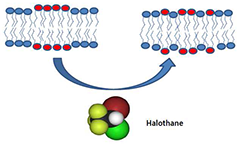You are here: Home > Section on Molecular Transport
Biophysics of Large Membrane Channels

- Sergey M. Bezrukov, PhD, Head, Section on Molecular Transport
- Philip A. Gurnev, PhD, Research Fellow
- Ekaterina M. Nestorovich, PhD, Contractor
- Tatiana K. Rostovtseva, PhD, Staff Scientist
- Kely L. Sheldon, MS, Predoctoral Intramural Research Training Award Fellow
- Oscar Teijido Hermida, PhD, Visiting Fellow
To address fundamental questions of membrane transport, we combine physical theory with experiments on mitochondrial and bacterial membrane channels reconstituted in planar lipid bilayers. Specifically, we focus on channel-facilitated transport of metabolites and other large solutes across cell and organelle membranes. The corresponding large ion channels are not only the gateways for metabolite exchange between various cellular compartments and cells, they are also recognized as multifunctional membrane receptors and components of many toxins. Disturbances in transport through ion channels result in a wide variety of pathologies in various organ systems, including cystic fibrosis, seizure disorders, muscular dystrophies, and cardiomyopathies, among others. Therefore, understanding of the physical mechanisms of channel-facilitated transport serves as the basis for development of new approaches to the treatment of diseases for which regulation of transport through ion channels plays a key role.
The channel-forming proteins we explore include anthrax protective antigen (from Bacillus anthracis), epsilon toxin (from Clostridium perfringens), VDAC (voltage-dependent anionic channel from the outer membrane of mitochondria), OmpF (general bacterial porin from Escherichia coli), LamB (sugar-specific bacterial porin from Escherichia coli), alpha-hemolysin (toxin from Staphylococcus aureus), OprF (porin from Pseudomonas aeruginosa), alamethicin (amphiphilic peptide toxin from Trichoderma viride), and syringomycin E (lipopeptide toxin from Pseudomonas syringae). To study these channels under precisely controlled conditions, we first isolate the channel-forming proteins from their host organisms, purify, and then reconstitute them into planar lipid-bilayer membranes. Our main goal is to elucidate the physical principles and molecular mechanisms responsible for metabolite flux regulation under normal and pathological conditions.
Interactions of multi-charged high-affinity toxin inhibitors with anthrax PA63 pore

Figure 1. Blocking anthrax on a single-channel level
A heptameric mushroom-shaped channel of PA63 produced by Bacillus anthracis is believed to be a translocation pathway for lethal and edema factor (LF and EF) inside the cell under attack (top). The idea is to design complementary heptameric low-molecular weight compounds—cationic cyclodextrins (bottom) that enter the pore and block it as molecular "plugs". The cartoon is a simplified illustration of the LF and EF penetration into the mammalian cell; in reality, the process is much more complex.
Oligomeric pore-forming bacterial protein toxins are among nature's most potent biological weapons. Many of them are listed as potential CDC category A and B priority bioterrorism agents. Currently, there are no effective treatments for intoxication mediated by pore-forming toxins secreted by Bacillus anthracis, Clostridium botulinum, Clostridium perfringens, or Vibrio Cholerae. Several other pathogens employ formation of trans-membrane pores in target cells in the process of infection, underscoring the importance of searching for new therapeutic agents that would exert their protective action at the level of the toxin oligomeric pore. Recently, using structure-inspired drug design, we demonstrated that aminoalkyl derivatives of beta-cyclodextrin inhibited anthrax lethal toxin action by blocking the trans-membrane pore formed by the protective antigen (PA) subunit of the toxin (Figure 1). As a next step, we studied the physical interactions underlying the high potency of one of the most effective toxin inhibitors, namely, cationic per-6-(3-aminopropylthio)-beta-cyclodextrin (AmPrbCD). The design of this inhibitor, the sevenfold symmetrical cyclodextrin molecule chemically modified to add seven positive charges, was guided by the symmetry and predominantly negative charge of the PA63 pore interior. The protective action of this compound has been demonstrated at both single-molecule and whole-organism levels. In this study (see reference 1), we examined the main features of AmPrbCD interactions with the anthrax pore. We started with a description of the pore conformational dynamics and showed that its voltage gating is lipid-dependent. Then, we quantified the effect of AmPrbCD concentration, applied voltage, and KCl concentration on the kinetic parameters of the binding, using single-channel current recording statistics as well as noise spectral analysis. We found that the action of this inhibitor is bimodal. When added to the cis-side of the membrane (the side of PA addition), AmPrbCD blocks the channel reversibly. At high salt concentrations, the blockage of the channel is well described as a two-state Markov process, in which both the on and off rates are functions of the salt concentration, whereas the applied voltage affects only the off rate. At salt concentrations lower than 1.5 M, the second mode of the AmPrbCD action on the channel is revealed: addition of the inhibitor enhances voltage gating, making the closed states of the channel more favorable. The effect depends on the lipid composition of the membrane. Most importantly, independently of lipid composition, the 50% inhibitory concentration of AmPrbCD is orders-of-magnitude smaller than that of mono- and doubly-charged compounds reported in literature, thus making per-substituted positively charged derivatives of beta-cyclodextrin the most potent small-molecule inhibitors of the anthrax channel found to date.
Biophysical properties of the membrane pore formed by epsilon toxin
Epsilon toxin is the major virulence factor secreted by the Gram-positive spore-forming anaerobic bacteria Clostridium perfringens types B and D. Epsilon toxin is responsible for a rapidly fatal enterotoxaemia in herbivores when their gastrointestinal tracts are colonized by these bacteria, which leads to in situ toxin production. Its toxicity is third only to the botulinum and tetanus neurotoxins. Similarly to anthrax, epsilon toxin is considered a potential biological weapon; its estimated lethal human dose is only several micrograms, with no efficient antitoxin yet known. To design a small-molecule blocker of the epsilon toxin pore similarly to the cyclodextrin-based potent inhibitors that we discovered earlier for the anthrax PA63 and alpha-hemolysin pores, we began by studying the pore's physical properties (see reference 2). As a first step, we used poly-(ethylene glycol)s of various molecular weights to probe the characteristic size of the pores formed by epsilon toxin in planar lipid bilayers. The idea of channel sizing is that small polymers enter the channel and reduce its ionic conductance while large polymers stay out of the channel and do not change its conductance appreciably. The characteristic size of the polymer that separates penetrating polymers from excluded ones gives information on the channel diameter. We found that the epsilon toxin pores are highly asymmetric. The cutoff size of polymers entering the pore through its opening from the cis-side, the side of toxin addition, is about 500 Da, whereas the cutoff size for the polymers entering from the trans-side is about 2,300 Da. Comparing these characteristic molecular weights with those reported earlier for OmpF porin and the alpha-hemolysin channel, we estimated the radii of cis- and trans-openings as 0.4 nm and 1.0 nm, respectively. The simplest geometry corresponding to these findings is that of a truncated cone. Second, we explored the ionic selectivity of the pore by measuring reversal potentials in oppositely directed gradients of potassium chloride aqueous solutions. As we had shown previously, such measurements allow one to judge the charge distribution along the channel axis. Interestingly, we found that the asymmetry of the reversal potential in the salt gradient is opposite to that reported for the conical nanopores with a uniformly spread surface charge. In the case of the epsilon toxin pore, the moderate anionic selectivity is salted out more easily from the wide trans-opening of the channel, suggesting that the residues carrying the positive charge responsible for the anionic selectivity of the pore are not localized at its narrow cis-opening but are shifted toward the trans-side.
Physical theory of channel-facilitated metabolite transport
This year, we studied new aspects of diffusion in confining geometries in order to further advance the continuum diffusion model of solute dynamics in a membrane channel proposed by us earlier. In many problems of practical and theoretical interest, motion of Brownian particles is spatially constrained (see references 3 and 4). When diffusion occurs in quasi–one-dimensional structures, it is intuitively appealing to introduce an effective one-dimensional description. However, there are limitations of such a description. Combining three-dimensional Brownian dynamics simulations with analytical results obtained by solving one-dimensional equations, we were able to establish a new criterion validating reduction to an effective one-dimensional description (see reference 5). We studied unbiased motion of a point Brownian particle in a tube with corrugated walls made of conical sections of a varying length. Effective one-dimensional description in terms of the generalized Fick-Jacobs equation was used to derive a formula that gives the effective diffusion coefficient of the particle as a function of the geometric parameters of the tube. Comparison with the results of Brownian dynamics simulations allowed us to establish the domain of applicability of both the one-dimensional description and the formula for the effective diffusion coefficient. Our analysis demonstrated that the usually accepted requirements are not sufficient for a successful reduction of the three-dimensional diffusion in a tube of a varying cross-section to the effective one-dimensional description; an additional factor should be taken into account, namely, the characteristic dimensionless wavelength of the radius variation should be large enough.
Additional Funding
- NIAID intramural biodefense grant (2009, ongoing) "From anthrax to botulism, cholera, and epsilon toxin: In search for broad-spectrum antitoxins that block virulent nanopores"
- USUHS CNRM grant (2009, ongoing) "Membrane biophysics of traumatic brain injury"
Publications
- Nestorovich EM, Karginov VA, Berezhkovskii AM, Bezrukov SM. Blockage of anthrax PA63 pore by a multi-charged high-affinity toxin inhibitor. Biophys J. 2010;99:134-143.
- Nestorovich EM, Karginov VA, Bezrukov SM. Polymer partitioning and ion selectivity suggest asymmetrical shape for the membrane pore formed by Epsilon toxin. Biophys J. 2010;99:782-789.
- Berezhkovskii AM, Pustovoit MA, Bezrukov SM. Entropic effects in channel-facilitated transport: inter-particle interactions break the flux symmetry. Phys Rev E. 2009;80:020904(R).
- Berezhkovskii AM, Pustovoit MA, Bezrukov SM. Fluxes of non-interacting and strongly repelling particles through a single conical channel: analytical results and their numerical tests. Chem Phys. 2010;375:523-528.
- Dagdug L., Vazquez M-V, Berezhkovskii AM, Bezrukov SM. Unbiased diffusion in tubes with corrugated walls. J Chem Phys. 2010;133:034707.
Collaborators
- Alexander M. Berezhkovskii, PhD, Division of Computational Bioscience, CIT, NIH, Bethesda, MD
- Leonardo Dagdug, PhD, Departamento de Fisica, Universidad Autonoma Metropolitana-Iztapalapa, Mexico DF, Mexico
- Daniel Harries, PhD, Hebrew University of Jerusalem, Jerusalem, Israel
- Vladimir A. Karginov, PhD, Innovative Biologics, Herndon, VA
- Adrian Parsegian, PhD, Program on Physical Biology, NICHD, Bethesda, MD
- Mark A. Pustovoit, PhD, St. Petersburg Nuclear Physics Institute, Gatchina, Russia
- Michael Weinrich, MD, National Center for Medical Rehabilitation Research, NICHD, Bethesda, MD
Contact
For more information, email bezrukov@helix.nih.gov or visit smt.nichd.nih.gov.


